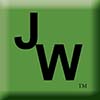w171
California
State Water Project
Anyone new to California’s often unique way of perceiving reality might believe that an insurmountable problem existed. After all, 70 percent of the state’s rivers and streams are found in northern and central California, while 80 percent of the demand for water emanates from the southland. California’s answer? Simply build 18 reservoirs to store seasonal runoff, and eight power plants to provide part of the electricity needed each year by the seven pumping plants that push 2.3 million acre-feet of northern California’s water through 600 miles of canals, pipelines, aqueducts and over mountains to the south state.
The history of the California Water Project is an unlikely combination of political cooperation, financing genius, and engineering marvels joining forces to provide flood control, hydroelectric power, farmland irrigation, recreation opportunities, and drinking water for two-thirds of all Californians. The California Legislature authorized the State Water Project in 1951 in order to meet the growing needs of a burgeoning California population. But another nine years elapsed before voters approved the Legislature’s Water Resources Bond Issue needed to finance the nation’s largest state-built, multi-purpose water project. Following passage of the 1960 Bond, construction progressed quickly; the first water deliveries were made just two years later.
The majority of the State Water Project took significantly longer than two years to complete. In Plumas National Forest, three dams were built between 1962 and 1966 on the Upper Feather River creating Antelope, Davis and Frenchman reservoirs. As runoff from rainfall and snowmelt created the three new lakes, all destined to become popular fishing spots, work on the remainder of the State Water Project continued.
In 1968, two years after water began filling the Upper Feather River reservoirs, the first of several State Water Project engineering marvels was completed. Oroville Dam became the tallest and one of the largest earth-fill dams in the world. It took more than 80 million cubic yards of gravel, and a thin inner layer of water impervious clay, to create the 770-foot tall dam. The builders of the dam didn’t have far to search for their gravel fill. Dredges from last century’s extensive gold mining operations along the Feather River had left behind plenty of gravel tailings.
Lake Oroville is the largest of the water project reservoirs, able to store more than 3.5 million acre-feet of water. During the exceptionally heavy rainfall of 1986, record inflows and releases were recorded. As the Feather River and smaller tributary streams dumped water into the reservoir at the rate of 266,000 cubic feet per second, the dam was able to reduce the potentially torrential down stream flow to just 150,000 cfs, significantly limiting flooding in the northern Sacramento Valley. Water released from Oroville Dam is also used to power the Edward Hyatt Hydroelectric Powerplant, which is housed in an area the size of two football fields, carved from solid bedrock. The hydroelectric plant’s maximum output of 678,000 kilowatts is sufficient to light all of Sacramento and Oakland.
Before being returned to the Feather River, some water released from Lake Oroville is diverted into the Thermolito Complex where additional hydroelectric power is generated. When Lake Oroville's Feather River water finally reaches the Sacramento–San Joaquin Delta, a relatively small portion is transported in buried, six-foot diameter pipelines to the North Bay Aqueduct for communities such as Travis Air Force Base, Fairfield, Suisun City and Vacaville. The Delta's Harvey O. Banks Pumping Plant lifts the remaining water supply 244 feet to the start of the California Aqueduct, the second of the State Water Project’s engineering fetes. The 444-mile long California Aqueduct, including its pumping plants and storage reservoirs, was completed and provided the first Feather River water to a thirsty south state in 1971.
For a public works project of such massive proportions, few of California’s citizens have actually seen much of their elaborate and expensive drinking water delivery system. The major exceptions are travelers along Interstate 5, heading south from near Tracy. The concrete channel of the California Aqueduct becomes a driver's companion much of the way to the base of the Tehachapi Mountains. Along Interstate 5, a few miles west of Santa Nella, San Luis Reservoir serves as a holding facility for water coming, not only from the California Aqueduct, but also from the federal government’s Central Valley Project. At times, the Central Valley Project seems at odds with the California Water Project as nearby canals and aqueducts sometimes carry water in the same direction, and at other times in opposite directions. Both the California Aqueduct and the federal Delta-Mendota Canal store water in San Luis Reservoir.
San Luis Reservoir, nestled in the foothills of the Diablo Mountains, is one of the State Water Project’s eight energy producing facilities. It also has the distinction of being the country’s largest “off-stream” reservoir–a reservoir filled with water pumped in from other watersheds. San Luis Reservoir’s Gianelli power plant generates electricity with water released from behind its 385-foot, earth-fill dam. The State Water Project’s share of the water, about half of the water stored at any given time in the 2,000,000 acre-foot capacity reservoir, leaves San Luis, pushed along on its journey down the Central Valley by a series of pumping plants.
At the base of the Tehachapi Mountains, near where travelers begin their long, steep climb over the Grapevine, the Edmonston Pumping Plant provides the biggest single boost to the aqueduct’s water. Fourteen, 420-ton motor-pump units, each using an 80,000 horsepower electric motor, reside in the U-shaped pumping plant. During full operation the motors use a total of 8.4 million watts to turn the 14 pumps which each hour can force more than 365 acre-feet of water up and over the 1,926-foot Tehachapi Mountain crest and across ten miles of mountains.
In the Tehachapi Mountains, the pipeline branches, sending some water west to Los Angeles and other southern coastal cities. Because the State Water Project’s demand for electrical power is so great, every potential for generating its own hydroelectric power is used. On the west branch, the Warne Powerplant takes advantage of the water rushing down from the crest of the Tehachapi Mountains. The plant generates enough power to actually recover about 25 percent of the original electricity that the Edmonston Pumping Plant used to pump water over the Tehachapi Mountains. With its energy drained by the Warne Powerplant, the water passes into Pyramid Lake, then onto the Castaic Powerplant and Castaic Lake, the west branch's terminus reservoir.
Similar to other pumping-generating facilities such as San Luis Reservoir, Pyramid Lake and Castaic Lake have the ability to reuse water for power generation. During weekday and daytime peak electric use periods in Los Angeles, Pyramid Lake’s water can be released to spin Castaic’s turbines and electric generators, producing “higher priced” electrical power. When local, non-peak power is sold at less expensive rates, such as at night and on Sundays, the Castaic plant pumps water back into Pyramid Lake for reuse during peak demand periods.
Water not sent toward Pyramid Lake is diverted to the east branch of the aqueduct. Near the Antelope Valley desert community of Pearblossom, the Pearblossom Pumping Plant boosts the water 542 feet, to an elevation of 3,749 feet above sea level, the highest point along the entire California Aqueduct. The water then loses only about one-foot in elevation as it slides downhill via both open aqueduct and underground pipe into Silverwood Lake, the highest reservoir in the project. From Silverwood Lake, water journeys through the San Bernardino Tunnel, then plunges 1,400 feet where the Devil Canyon Powerplant wrings the last of the hydroelectric power from the water. After Devil Canyon, it’s a more leisurely trip through the Santa Ana Valley pipeline and into Lake Perris, the most southerly reservoir of the State Water Project.
The State Water Project has done more than provide much needed drinking water supplies to desert-dry southern California, or water for irrigating California’s rich farmlands. It has also proved a major benefit for fish and wildlife, and opened innumerable recreation opportunities for Californians.
In 1967, the Feather River Salmon and Steelhead Hatchery was opened. Its construction was designed to compensate for the loss of many miles of valuable Feather River spawning and nursery grounds inundated by Lake Oroville’s water. Capable of incubating 13 million salmon eggs and two million steelhead eggs, the hatchery is essential in maintaining adequate levels of anadromous fishes for down river and Pacific Ocean sport and commercial fishing.
Recreational opportunities abound along the 600-mile State Water Project. Although northern Californian's have always had easy access to lakes and streams, many more swimming, boating, fishing, hiking, camping and even waterfowl and upland game hunting opportunities now exist for water-starved southern Californians. In addition, dozens of popular fishing access points have been established all along the length of the aqueduct. Between 1962 and 1988 Californians logged an estimated 98 million user days along the project's waterways.
The cost of construction, maintenance and operation of the State Water Project is borne by its many beneficiaries. Most of the costs, including principal and interest payments on the original $1.75 billion 1960 construction bond, are paid by the project’s 30 contracting public water agencies. The federal government funds the costs associated with flood control provided by the project’s dams, while the state of California provides programs for the enhancement of fish and wildlife and for the numerous recreational opportunities found along the aqueduct and its reservoirs.
When the final improvements and additions to the State Water Project are completed, it will be able to deliver 4.2 million acre-feet of water each year, nearly twice its current delivery capacity of 2.3 million acre-feet per year. Of the total deliveries, 30 percent will irrigate the state's farmlands, while 70 percent will supply the daily water needs of California's increasing population. The State Water Project is a one government venture that has paid, and continues to pay, valuable dividends to all Californians.
Copyright 2015 by Publishing Syndicate, all rights reserved.
For permission to reprint text or photos contact Ken@PublishingSyndicate.com

w172
Crocker Art Museum
Sacramento
One of Sacramento’s venerable 19th century mansions also has the distinction of being the longest continually operating art museum in the West. The Crocker Art Museum began when Judge Edwin B. Crocker and his wife, Margaret Eleanor Rhodes Crocker, purchased what was originally a much smaller home in 1868. Crocker then commissioned an architect to redesign the home into something much more representative of his place in society. A large part of his vision included adding an entire new wing to the Italianate mansion. The new structure included a bowling alley, skating rink, and a billiards room on the ground floor; a library and natural history museum on the main floor; and gallery space for the Crockers’ growing art collection on the upper floor. Today, upon entering the museum through the oversized front doors, it is immediately obvious that the Crockers spared no expense, combining the finest hardwoods and tiles with impeccable workmanship.
Although initially trained as a civil engineer, Crocker also studied law and ultimately made his money after he and his second wife came to California in 1852. Here, he renewed the law practice he had in Indiana and became involved in Republican politics. Following Lincoln’s election as US president and Leland Stanford’s election as California’s governor, both in 1861, Crocker was appointed as a justice to the California Supreme Court in 1863. The following year, he became the legal counsel for the Central Pacific Railroad Company, organized in part by his brother Charles Crocker, one of the railroad’s “Big Four,” along with Stanford, Mark Hopkins, and Collis P. Huntington.
Crocker suffered a stroke in 1869, and afterward retired from the railroad. It was then that he began renovating his newly acquired home—or at least hired the architect to handle it for him. While the work was being done, Crocker and his family left for Europe and didn’t return until 1871, moving into the newly renovated mansion with its large art gallery in 1872. They returned with hundreds of pieces of art acquired during their extended European vacation.
Unfortunately, Edwin Crocker died just three years after moving into his new home, and in 1885, Margaret Crocker gave the Crocker Art Gallery and most of its collection to the city of Sacramento and the California Museum Association. She spent her remaining years shuttling between homes in Sacramento, San Francisco, Lake Tahoe, Los Angeles, and New York. Margaret Crocker died in 1901.
The initial Crocker collection included 700 paintings and 1300 Old Master drawings, which, today, is one of the finest collections anywhere. At the time, Crocker’s art collection was one of the largest privately held collections in the country.
Something that makes the museum especially important to California is its collection of works by early California artists. One of the best known, if not by name, certainly by his work, is Charles Christian Nahl and his painting, Sunday Morning in the Mines. The 9-by-6-foot oil painting hangs above the grand staircase to the upper floor and depicts the two “idyllic” sides of life in the California gold mines—that of dedicated good miners spending their Sunday reading, doing laundry, and writing letters home, contrasted with the carousing, drunken, fighting madness of the other side. At the opposite end of the gallery is Thomas Hill’s even larger and more glorious painting, Great Canyon of the Sierra, Yosemite. In the surrounding gallery are dozens of paintings by Dutch, Flemish, German, and other European artists.
Over the years, the museum has added additional wings, and it continues to grow, with another 100,000-square-foot expansion planned for 2008. The museum’s growing collection of art, not only its paintings and drawings, but its collection of international ceramics, is a wonderful complement to an incredibly beautiful 19th century home.
Hours: Tuesday through Sunday, 10 a.m. to 5 p.m. (open until 9 p.m. on Thursday); closed Monday, Thanksgiving, Christmas, and New Year’s Day.
Cost: Adults, $6; 65 and older, $4; students (with ID), $3; under 6, free
Location: 216 “O” Street, Sacramento
Phone: 916-264-5423
Website: www.crockerartmuseum.org
Copyright 2015 by Publishing Syndicate, all rights reserved.
For permission to reprint text or photos contact Ken@PublishingSyndicate.com

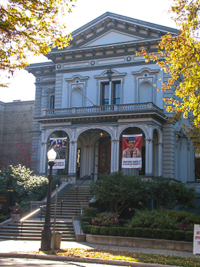
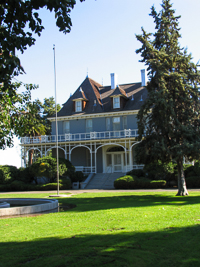
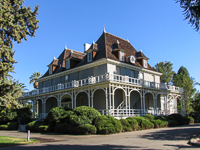
w173
Kearney Mansion
Fresno
Martin Theodore Kearney—the Fresno County raisin baron—constructed this gorgeous mansion as his temporary residence, while his much larger mansion—the Chateau Fresno—was being built. Unfortunately, Kearney died in 1906, shortly after ground was broken for his chateau, so construction was halted on the home and never resumed.
Kearney was born in 1842 in England to Irish parents. At the age of 12, he traveled with his working class parents to the US, where they settled in Massachusetts. When he turned 18, Kearney headed for Boston and quickly worked his way from salesman to manager of a trunk business. During those five years, Kearney focused on learning the “ways of a gentleman,” studying foreign languages, dancing, and more.
In 1869, Kearney was ready for California, and he arrived looking and acting every part the gentleman he had worked so hard to become. He also arrived with money and promptly purchased 8640 acres in Fresno County, paying just $2.50 per acre. Kearney had made the purchase, sight unseen, from the land’s owner while on board the ship that carried him from the East Coast to San Francisco. That same owner, Dr. Edward B. Perrin, convinced Kearney that with the introduction of irrigation, the land would produce rich harvests. Kearney thus envisioned the creation of an agricultural development where he would install the needed irrigation canals, roads and other infrastructure across his newly acquired land. He would then sell 20-acre parcels to investor-farmers who would grow a variety of crops, which ultimately included grapes that could be dried into raisins. Successfully enlisting the help of several financial backers, Kearney became the key promoter and the manager of the first successful “farm colony” in the Central Valley. Kearney and his associates, along with various financial supporters, purchased additional lands and went about developing and selling nearly 200 parcels.
In March 1883, Kearney purchased another 6800 acres near Fresno and called it his Fruit Vale Estate. It was here that he planned to expand what was turning out to be a very profitable business, growing grapes and drying raisins. He tried to convince other growers in the area that working together would benefit everyone. In 1898, Kearney founded the California Raisin Growers’ Association, designed to both improve the quality of raisins and also to better market raisins to the rest of the country and to the world. Kearney was successful in convincing many growers to join forces, but the eight years that his association existed were described as stormy, as the very independent growers vied for support of their own points of view and interests. Following Kearney’s death in 1906, many of those same growers founded a new organization, adapting the majority of Kearney’s original policies and procedures. Their new cooperative evolved into today’s Sun Maid Growers of California.
Prior to his death, Kearney had made arrangements that upon his death, 5400 acres of raisin vineyards—his Fruit Vale Estate, valued at $1.5 million—were to be given to the University of California. Today, the 225 acres surrounding the mansion are a county park. The Kearney Mansion and the park are on the National Register of Historic Places, and are open to the public. The Fresno County Historical Society manages the home’s public tour program.
The Kearney Mansion is actually two separate buildings, both rectangular and built with unseen 2-foot-thick adobe brick walls. An elaborate French Renaissance design covers the adobe walls with a layer of painted plaster, topped with high, peaked roofs and dormers. The entry has both original and non-original furnishings; the carved chairs and bench are originals from Germany, while the carpeting is a reproduction.
One of the more interesting rooms is Kearney’s personal office. It includes plans for his five-level Chateau Fresno, along with numerous photographs and other documents the land and raisin baron used when he sat in this very room more than 100 years ago. On the second floor, Kearney’s large bedroom and private bathroom contain many features original to the home, including his brass bed and maple furnishings.
Hours: Friday, Saturday, and Sunday, hourly, 1 p.m. to 3 p.m.; closed on legal holidays that fall on Friday, Saturday, or Sunday
Cost: Adults, $5; seniors and students, $4; 12 and under, $3
Location: 7160 West Kearney Blvd., Fresno
Phone: 559-441-0862
Website: historicfresno.org/nrhp/kearney.htm
Copyright 2015 by Publishing Syndicate, all rights reserved.
For permission to reprint text or photos contact Ken@PublishingSyndicate.com

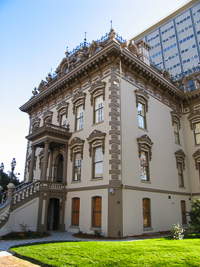
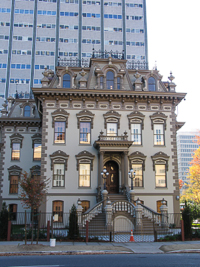
w174
Leland Stanford Mansion Sacramento
It may be little difficult to envision how this 19th century mansion appeared when it was first constructed in Sacramento in 1857. At that time, the surroundings were much more rural, with mostly open land and only a few scattered homes nearby. Today, more recently constructed state office buildings dwarf this four-story, 19,000-square-foot former home of railroad developer and Governor Leland Stanford.
The mansion was originally built by Sacramento merchant Shelton Fogus, who constructed a much smaller, Renaissance Revival-style home. Leland Stanford, one of the Central Pacific Railroad’s “Big Four,” purchased the home in 1861, and over the next few years, he quadrupled the size of the house and significantly altered its exterior appearance. One of those remodels included elevating the house about 12 feet so the main living quarters would no longer be susceptible to the periodic flooding from the nearby Sacramento and American rivers.
Stanford came to California in 1852 to join his two brothers, already successful businessmen in Sacramento. With a partner, Stanford started his own business, which soon proved very successful. Additional business successes followed, putting him in the company of other well-to-do businessmen and into the middle of California’s developing politics. As one of the founders of the California Republican Party, Stanford felt his many political ties would guarantee his election to the highest state office, and thus, he began the final major expansion of his mansion. He wanted to ensure that it would be suitable as a home and office for California’s governor. Stanford’s prediction came true, and in January 1862, he was sworn in as governor of California.
In 1868, Leland Stanford, Jr., was born to his proud—and very rich—parents. They traveled extensively with their son, introducing him to museums and historical sites throughout the world. Unfortunately, while traveling in Florence, Italy with his parents, Leland Jr., at age 16, died of typhoid fever. His parents decided that the “children of California” would now become their children. They significantly expanded their already generous giving by founding and endowing the Leland Stanford Jr. University in Palo Alto, officially known as Stanford University, today.
Stanford became a US senator following his time as governor, but he died in that office in 1893, leaving the future of his estate questionable. Later, his wife, Jane, sold their San Francisco home—much bigger than their Sacramento mansion—and gave the funds to the young and struggling Stanford University to ensure its financial survival.
Jane Stanford also donated their Sacramento home and all of its furnishings to the Catholic Church for use by the Sisters of Mercy as an orphanage, the same order that had cared for her son during his fatal illness in Italy. In later years, it became a residence for dependent high school girls. One of the upstairs bedrooms has been restored to reflect this period of the home’s history. The state of California acquired the property in 1978, but the Sisters remained here until 1987. The mansion has since undergone a major restoration.
One of the first things the Sisters of Mercy did when they turned the mansion into an orphanage was to remove all the Stanford’s furniture, art, chandeliers, and the gold-leaf-framed mirrors. Today, all of those original items have been returned to the home, so most of what is in the rooms was here when the Stanfords lived here. On the tours, old photos show how closely the rooms appear to their original status, from paintings and pianos to carpets and drapes. Stanford incorporated a theme from his most successful business, the Central Pacific Railroad, into some of his furniture, especially in the dining room, where the locomotive motif can be seen in many of the pieces.
During its history, the home also served as the “Gubernatorial Mansion” for three governors, Leland Stanford, Frederic Low, and Henry Haight. Today, it once again serves as a ceremonial office for California’s governor, and tour groups are allowed to peak in on the office, although the governor only rarely makes appearances here. The mansion is also reserved for important gatherings of the governor and first lady, some state agencies, and the legislative leadership, including the speaker and the president pro tempore. The visitor center next to the Stanford Mansion features a short introduction film to the lives of Leland and Jane Stanford. There are also several exhibits reflecting the family’s history here.
Hours: Daily, 10 a.m. to 5 p.m.; tours are on the hour, with the last beginning at 4 p.m.; closed Thanksgiving, Christmas, and New Year’s Day. Although the mansion is open for public tours at least 75 percent of the time, call ahead and confirm that it hasn’t been reserved for use by the governor or others.
Cost: Adults, $8, 6-17, $3
Location: 800 N Street, Sacramento
Phone: 916-324-0575
Website: www.parks.ca.gov
Copyright 2015 by Publishing Syndicate, all rights reserved.
For permission to reprint text or photos contact Ken@PublishingSyndicate.com

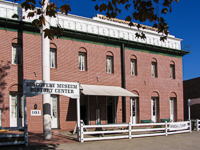
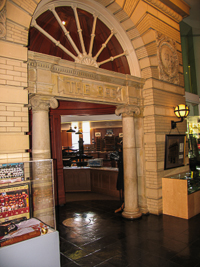
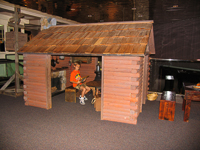
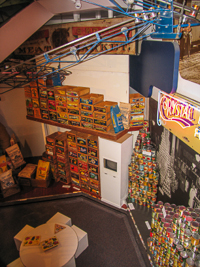
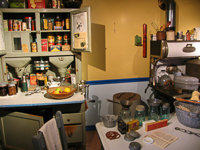
w175
Sacramento
History Museum
Sacramento’s history is woven into the contemporary fabric of this “city of trees.” The History Museum has taken a slice of that history and made it available for all to see. Newspapers have been a part of Sacramento since its founding at the beginning of the Gold Rush. The Sacramento Bee, the city’s second oldest (founded in 1857) and only surviving newspaper offers a look at the technology for printing and documenting the city’s daily news for the past century-and-a-half.
One of the more fascinating exhibits is the floor, believe it or not! A large section is constructed of clear glass, and while walking on it is a strange sensation, it allows you to see below ground level. Beneath your feet an exhibit showing many of the artifacts, especially pieces of china, unearthed by archeological digs throughout Sacramento.
Take the escalator to the second level and enter the world of “Gold Rush Gulch” during Gold Rush California. Partly designed for younger set, there is a child-size miner’s cabin with everything from a stove and pans available for kids to play with. Other exhibits include gold tools and clothes, their shelters and “alternative” homes such as the boarding houses where during the cold winter months a miner could live for $3 a week.
Most people visiting the museum will likely be struck with a slight case of “gold fever” while viewing the displays of real gold in its many forms. From nuggets and veins in quartz to its loose form found in rivers, the gold will demonstrate its power to draw anyone into its world. In addition to showing the real stuff, the museum touches on the types of mining done in California, from placer and hydraulic mining to the deep hard rock mines. And it explains the early prolific use of hazardous chemicals, such as mercury, commonly used to extract the gold from its ancient hiding places.
Beyond the gold, the museum begins a timeline of exhibits that start with crossing the Plains and some of the more common items these hearty adventurers had with them. River transportation was an important part of Sacramento’s early days, and again for the kids, there is a replica of the wheelhouse of the Eclipse, a paddle wheeler that plied the river between Sacramento and San Francisco. There are costumes inside the wheelhouse for kids to dress-up and play their favorite roles—and an opportunity for parents to take some memorable photographs of their museum visit.
The 1850s includes fire engines and the fires that burned parts of the city; an old syringe that belonged to Dr. Frederick Hatch who, with his family survived a shipwreck near San Francisco before making it to Sacramento to begin his practice. The ine thing noticeably different from today’s needles is the size. They used some really BIG needles in those early days.
There is the accidental 100-year-old time capsule, a fascinating look back at a young girl’s life. Apparently the heartbroken parents of their 12-year-old daughter who had died of encephalitis in 1879, put her clothing and toys in a trunk and locked it away behind a stairwell. During restoration of the Sacramento Victorian in 1987, the home’s newest owners discovered the long-forgotten treasures.
In many of California’s history museums there is usually a little said about the Chinese who settled throughout the state. The museum has a wonderful collection of 19th century Chinese dolls of every description. There is also additional information about the Chinese and their lives in early California.
As the years progress the exhibits include more of the common things that were part of the lives of the people living in and around Sacramento. And they aren’t any different than found in any large city’s history museum, from Kodak cameras to musical instruments. Exhibits move through the two World Wars and into a 1950s dining room setup with those yellow vinyl chairs.
Sacramento has always been an agricultural town, and a large exhibit back on the first floor shows the connection with the many large canneries here. The many company labels on the wooden packing crates illustrate the diversity of crops, from tomatoes to pears, raised on the surrounding farms. One of the area’s biggest crops remains almonds, and there’s an early almond huller that managed to take much of the hand labor out of packaging shelled nuts.
Hours: Labor Day to Memorial Day, Tuesday through Sunday (and Monday holidays), 10:00 a.m. to 5:00 p.m.; Memorial Day through Labor Day, open daily from 10:00 a.m. to 5:00 p.m. Closed Thanksgiving, Christmas, and New Year’s Day
Cost: Adults $5; Seniors (60 and over) $4; Ages 13-17 $4; ages 4-12 $3; under age three are free
Location: 101 “I” Street, Old Sacramento
Phone: 916-264-7057
Website: www.thediscovery.org
Copyright 2015 by Publishing Syndicate, all rights reserved.
For permission to reprint text or photos contact Ken@PublishingSyndicate.com

w176
Old Sacramento
Situated at the confluence of two great rivers, the Sacramento and the American, the city began life in 1939 as Sutter’s Fort, the center of Swiss immigrant John Sutter’s Mexican land grant he named New Helvetia. Ten years after its founding, the fledgling town of New Helvetia, soon named Sacramento, became a key transportation center for Gold Rush travelers, miners, and merchants. By end of the 1860s, the growing city’s place in California history was already well on its way to permanency when it had become the western terminus for the Pony Express, the kick-off point for the Central Pacific Railroad’s share of the transcontinental railroad, and home of the state’s capital.
What many people find fascinating about Old Sacramento is the fact that it was destroyed by floods (and fire) a few times during its early days. To defeat the fires, many of the building were constructed of brick with iron window shutters. To defeat the Sacramento River’s nearly annual floods, they simply raised the city about 15 feet with thousands of wagon loads of fill dirt. Raising the existing buildings was a little trickier. Some of the original buildings became basements, with second or third floors added to reach street level. Other buildings they slowly raised with screw jacks, filling in beneath their foundations as they pushed entire structures up to the new street level.
Sacramento has preserved, restored, and reconstructed pieces of its history. From the 19th century buildings and the many museums in Old Sacramento, to the historic home of past governors, Sutter’s Fort, and the State Indian Museum, much of the city’s past is alive and doing well.
Copyright 2015 by Publishing Syndicate, all rights reserved.
For permission to reprint text or photos contact Ken@PublishingSyndicate.com

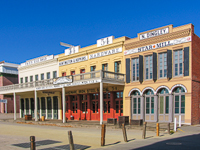
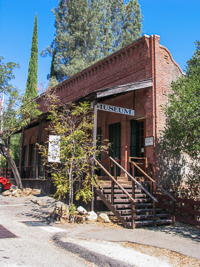
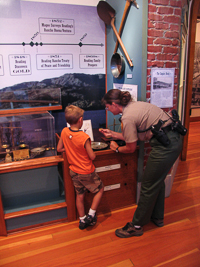
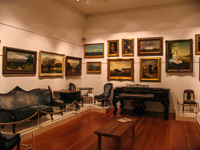
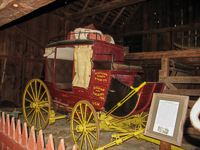
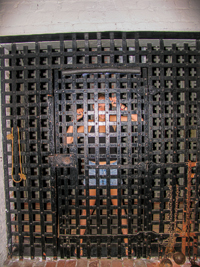
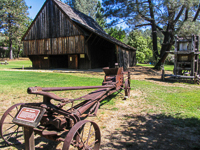
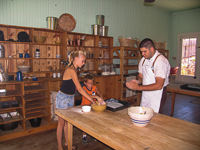
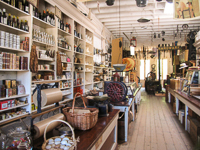
w177
Shasta
State Historic Park
James Marshall discovered gold in January 1848, but the Gold Rush didn’t begin in earnst until 1849. Those few Americans already living in California got the jump on the tens of thousands who came during the next few years. One of those lucky early settlers was Pierson B. Reading who discovered gold nuggets in Clear Creek. By 1849 a community of tents had sprung up around the main gold diggings and called Reading Springs. The developing town quickly became a transportation hub, acquired permanent buildings and homes and in 1850, a new name: Shasta.
Following two major fires in less than a year that destroyed the town’s wooden buildings, business owners rebuilt a third time, using fireproof brick and iron shutters. Even with such improvements, Shasta’s boom times lasted only a dozen years. When the gold fields played out, the stage lines left, and the new Central Pacific Railroad laid tracks in the nearby valley town of Redding, Shasta died.
Today, many remnants of the old brick business buildings still line Highway 299, the town’s main street. A few of the buildings have been restored and now function as active parts of the historic park and museum. The Courthouse Museum, much of it constructed in 1853, has been restored to its 1861 appearance. Many surprises wait inside what began its existence as three separate businesses and later become the courthouse after fire destroyed the original courthouse. Today, the museum is used by many schools for its educational value.
The museum holds a collection of California Indian baskets, mortars and pestles, and other tools used for food preparation. In contrast is the exhibit dealing with living conditions for the early settlers and gold miners. The chamber pot and handgun speak volumes about the comfort and safety of guests in one of the local hotels.
Some of the bigger mining towns acquired nicknames, and Shasta was no exception. Its long row of brick buildings and the large population that lived here brought it the title of “Queen of the North.” It was the largest town in the area, which attracted people from all over the hills who needed supplies, equipment repaired, and a little social interaction.
The courthouse, which is located in the back of the museum, looks much as it did in the 1860s when it was used for marriages, hearings, and trials. For those whose luck ran out and were found guilty of murder, it was a short trip down the unlucky 13 stairs to the jail cells where they awaited their final walk. The jail has been restored and you can spend a little time behind bars your self, or try on the leg irons attached to a chain. During its use, three convicted murderers walked out the back door to the gallows where they where “hanged by the neck until dead.” The gallows, reconstructed for the museum, was always dismantled following each hanging and reconstructed for the next.
Back in the front of the museum in one of the side galleries is one of the most extensive collections of early California art, many painted by Californians. There are nearly 100 paintings by 71 artists in the overall collection. Paintings from the collection are often borrowed by “big-city” art museums for special showings. The subjects of the collection range from pastoral settings to portraits to early cityscapes. Some of the artists and their works are well known both in this country and abroad where many worked and studied art. The collection’s portrait of John Augustus Sutter (1859) was painted by Emmanuel Leutz who was a very popular painter of historical scenes. He is probably best known for his often seen painting of Washington Crossing the Delaware.
One of the best things about the museum being part of a state historic park is the fact that there is more here than just the one museum. Take a little trip back in history and wander across the street and visit the two stores and bakery (use the crosswalks and be careful crossing the highway; cars don’t always slow as they should). The two stores bring back a time when self-service, rows of cashiers, and piles of discount merchandise where unknown. The Litsch General Store is a museum, itself. Even though some of the merchandise is available for sale, much of the store is filled with tools, supplies, and foodstuffs that would have been found here 150 years ago. Back then, most merchandise was displayed behind the counter and shown to inquiring customers by the store clerk.
The Blumb Bakery is next door to the store. If you timing is right, you can actually help bake cookies—and enjoy the fruits of your labors, hot out of the old brick oven. This is great fun for kids who often tire of touring museums.
There is more to see if you choose to wander around the park, from the Pioneer Barn to the old cemeteries. The Union Cemetery, like many old graveyards, tells its own stories about the history of this Gold Rush town. From the oldest grave (1852), to the causes of death engraved on the markers, here are stories about Indian attacks, the dangers of childbirth, and these settlers’ countries of origin.
Hours: Wednesday through Sunday, 10:00 a.m. to 5:00 p.m. Closed Thanksgiving, Christmas, and New Years Day.
Cost: Adults, $2; ages 15 and under are free
Location: Highway 299 West, in the town of Shasta
Phone: 530-243-8194
Website: www.parks.ca.gov
Copyright 2015 by Publishing Syndicate, all rights reserved.
For permission to reprint text or photos contact Ken@PublishingSyndicate.com

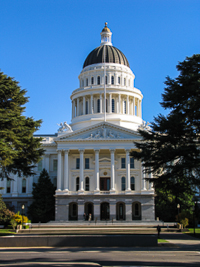
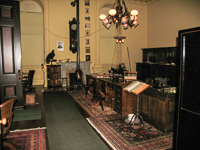
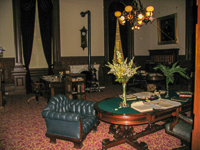
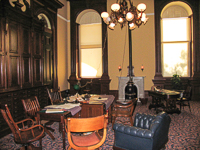
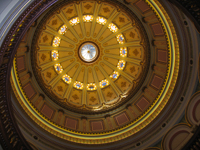
w178
California
State Capitol Museum
California has enjoyed a tumultuous history, and that turbulence is no more evident than with the state’s capitol. Aside from the never-ending disagreements that have gone on inside the Senate and Assembly chambers since it was opened for business in 1869, the arguments began even before California gained statehood in 1850. The state’s constitution was written and passed in Monterey, the first capital, which then was moved north to San Jose, then to Vallejo, then to Sacramento before going back to Vallejo, then north to Benicia before finally landing in Sacramento for the last time in 1854. Even in subsequent years, Oakland, San Jose, and Berkeley attempted to “steal” the capital, with Monterey making the last failed bid in 1941.
One thing that makes this “museum” unique is that it is a working museum. While you can gaze at (or take guided tours through) the restored historic rooms including the Governor’s office (1906), the Attorney General’s exhibit room (1906), and the Secretary of State’s office (1902), upstairs today’s Assembly and Senate are at work making real laws, while the present-day governor’s office is just down the hallway.
Be prepared to walk through the metal detectors when entering the Capitol these days. Inside, assuming you entered through the main west entrance where the giant state seal is embedded in the walkway, what first becomes visible is the rotunda of this Italian Renaissance Revival building. What most people don’t notice is that the beautifully painted interior rotunda actually is nestled inside the much larger and taller exterior rotunda viewed from the capitol grounds. Out of view is a rickety spiral stairway that rises between the top of the interior rotunda and allows access to the capitol’s cupola, that tiny perch at the very top of the building. Unfortunately the cupola is off limits to the public, although there a view from the tiny perch is available on the Capitol’s website.
The restored historic portions of the capital are situated across the west end on the main floor. While most of the restored historic offices remain relatively static, other exhibits are changed to reflect different aspects of California’s history. While you can view the historic offices through their doorways from the main hall, it is best to take one of the free tours. The tours will take you inside the offices where you will see much more, plus get the story about what was happening at that moment in time. For example, the governor was dealing with the 1906 San Francisco earthquake. Stacked on his desk are telegrams and newspaper accounts of the disaster. And notice the “extension” cords draped from the chandeliers to the desks. Things have changed!
There are two historic State Treasurer’s offices, one from 1906 and the other 1933. The biggest difference, at least for those working there, was that in 1905 the safe held California government’s entire account of $8 million in gold and silver coin. A few years later the legislature changed the law allowing the Treasurer to move the state’s funds to banks and other investments. In 1933, the office safe held only $23,000 in cash, with the remainder being bonds and securities.
There is much more to see both inside and outside the capitol building. Walk through much of the annex (built in 1951) near the present-day Governor’s Office and there are displays from each of California’s 58 counties, featuring what is most important to each. You can actually walk into the Governor’s Office, or at least into the secretary’s office if you like. You may get lucky and catch a glimpse of the Governor walking through to his office or to the “Horseshoe” offices where much of his staff take care of the Governor’s day-to-day business with the legislature and the public.
In the basement, beneath the rotunda is a series of murals painted originally around the main floor rotunda in 1913 by San Francisco artist Arthur F. Mathews. In his “California decorative style,” a combination of romantic classicism using Renaissance colors, Mathews and his wife Lucia Kleinhans Mathews, interpreted California’s history through their impressive murals. The panels were removed from the main rotunda during the Capitol’s 1976 restoration and moved to the basement in order to restore the rotunda to its original state.
The capitol is situated near the west end of a 40-acre park, originally designed as a Victorian garden. It has changes since those early days, but offers many monuments and memorials. One of the more impressive and moving is the Vietnam War Memorial. For those interested in trees and flowers, Capitol Park features exotic plants from around the world, a trout pond, and large rose garden.
Hours: Daily tours from 9:00 a.m. to 4:00 p.m.; building hours daily from 8:00 a.m. to 5:00 p.m. Closed Thanksgiving, Christmas, and New Year’s Day.
Cost: Free
Location: Capital Avenue at 9th Street, Sacramento. The museum tour office is in the Capitol building basement, room B-27.
Phone: 916-324-0333
Website: www.parks.ca.gov or http://capitolmusuem.ca.gov
Copyright 2015 by Publishing Syndicate, all rights reserved.
For permission to reprint text or photos contact Ken@PublishingSyndicate.com

w179
California
State Indian Museum
The California State Indian Museum, which focuses solely on California’s Native Americans and their cultures, is housed in a relatively modest adobe building situated in the shadow of Sutter’s Fort in Sacramento. The museum houses only a small portion of the collection maintained by California State Parks, yet it provides a great overview of Native American life, primarily in northwestern California, from before European contact to modern times.
The best estimates place California’s Indian population at about 300,000 prior to the arrival of the first Europeans, the Spanish. California’s Indians were a widely diverse group, speaking 120 different languages. Unfortunately, disease, extermination campaigns by settlers, and destruction of their food sources reduced their population to about 150,000 by the time the Gold Rush hit.
This museum houses several exhibits on the ceremonial aspects of California’s Native Americans. Religious rituals and the regalia associated with them were central to the Indians’ daily lives. Dances celebrated life, cured illnesses, and honored ancestors. Those who led these dances, and those who provided the specialized clothing often worn by others, were generally the Indians within the tribe who had accrued more wealth, either through trading, marriage, or gambling. The White Deerskin Dance, using an albino deer skin and associated necklaces, was just one of the ceremonial dances. The museum’s exhibit shows many of the sacred items used in this dance.
The largest artifact in the museum is a dugout canoe from California’s North Coast. The canoes were carved from solid redwood logs, a specialty craft that only a few Indians mastered. Yet the craft served them well, allowing access to the ocean and rivers where fish and other seafood could be harvested.
Hunting and fishing provided most of the required sustenance for these early peoples, especially along the North Coast. Fortunately, this region provided ample wildlife, from elk and deer to millions of ducks and geese, along with an abundance of fish and other creatures from the ocean, lakes, and rivers. Add to this the acorns from the millions of oak trees that once covered California’s hills and valleys, and the Native American population had a surplus of food. The museum includes examples of hunting and fishing tools, from bows and arrows to fish nets and fish traps, and even fish hooks made from bone.
The museum also covers the trade among the Indians. Most likely, the different tribes did not travel far in their trading. Yet many goods, including coastal shell beads, clay pottery, and obsidian used for projectile points, would be traded from tribe to tribe, often ending up hundreds of miles from their points of origin.
One of California’s Indians’ most highly developed skills was weaving baskets. Not only can you see the finely crafted baskets used for day-to-day work, such as gathering and processing acorns, carrying children, storing food, and cooking, there is a wonderful collection of “art” baskets. That’s not likely how the Indian creators classified their works. Rather, they used them to show off their skills; the better weavers created the tiniest baskets possible, some about the size of a child’s marble. Still, the tiny baskets retained the shape and even the color patterns of their big brothers. Other basket makers incorporated the most brilliantly colored feathers possible, such as those from hummingbirds.
Kids will delight in the chance to play with several pelts from various animals that the Indians would have used for clothing, tools, and more. Many Indians made ornamental beads by drilling holes through the middle of rounded seashells. The museum also has a small, hand-powered stick “drill” that kids are encouraged to try their hands at drilling holes into a board. It’s the same kind of hand-powered drill that could be used to start fires.
The museum features a small exhibit on one of California’s most famous Indians, Ishi. The last known surviving “wild” member of the Yahi Indians, Ishi had lived in the Lassen foothills above Oroville. A rancher found him in 1911, starving, weak, and fearful. Ishi spent the next five years, until his death, demonstrating his Indian culture and skills for the anthropology department professors at the University of San Francisco. Ishi provided researchers valuable insights into his and his peoples’ past.
The museum also shows a short film on California’s Indians, and during several annual events provides opportunities to more closely experience Native American cultures. Around the outside of the museum are some of the plants used by California’s Indians. A pamphlet describes a self-guided walk that leads to plants used for everything from food to basket-making materials to medicine.
Hours: Daily, 10 a.m. to 5 p.m.; closed Thanksgiving, Christmas, and New Year’s Day
Cost: 17 and older, $2
Location: 2618 K Street, next to Sutter’s Fort, Sacramento
Phone: 916-324-0971
Website: www.parks.ca.gov
Copyright 2015 by Publishing Syndicate, all rights reserved.
For permission to reprint text or photos contact Ken@PublishingSyndicate.com

w180
Sutter's Fort
State Historic Park
It was at Johann Augustus Sutter’s sawmill, located about 50 miles from Sutter’s Fort (Sacramento) on the South Fork of the American River, where James Marshall discovered gold in 1848, kicking off California’s Gold Rush. Just the winter before, Sutter had sent rescue teams looking for survivors of the ill-fated Donner Party, who spent much of the winter trapped, starving, and freezing near the crest of the Sierra Nevada.
Today, Sutter’s Fort, partially restored and partially reconstructed, serves as a living museum to California’s early pioneers. It’s a great place for kids, especially during the monthly Pioneer Demonstration Days and the periodic Living History Days. On these special days, volunteers dress in period clothing and do everything the early settlers would have done from working in the blacksmith shop, making candles, baking bread, weaving cloth, and more. These fun days are filled with opportunities to see how Sutter and his settlers worked and lived here more than 150 years ago. There are also numerous exhibits throughout the fort that deal with everything from the Indians to Sutter to the Gold Rush. One of the smallest exhibits—and one of the most interesting—is the tiny doll that belonged to 8-year-old Patty Reed, one of the Donner Party survivors.
John Sutter was born in Germany in 1803, but he was a Swiss citizen. He traveled a very circuitous route to his new California home. In 1834, at the age of 31, Sutter left his wife and five children and sailed from Europe to New York. He settled in Missouri for a while before heading to Santa Fe and then moving to Kansas in 1837. By 1838, his businesses, which included a hotel, were not successful, so he packed his belongings and went to work for the American Fur Co., ending up at the Hudson’s Bay Co. headquarters in Fort Vancouver (today’s Washington state). From there, he sailed to Hawaii, and after being stuck in the Sandwich Islands longer than he had planned, sailed for Sitka, Alaska, before being directed to land at the official port of entry at Monterey instead of his destination, Yerba Buena (San Francisco). Finally, in 1839, Sutter and his eight Hawaiian workers made it up the Sacramento River in smaller boats and landed near what one day would be 28th and C streets in Sacramento.
In 1840 Sutter became a Mexican citizen, which was required in order to own land, and Mexican Governor Alvarado granted him 48,000 acres. While Sutter’s vision for the settlement he called New Helvetia (Sacramento) was set high and likely achievable, events that changed the history of California, coupled with his own business ineptitude, caused him to lose everything. Sutter employed local Indians to help build his adobe fort and the interior buildings, including his own headquarters in the central building (which can be toured today). In addition to quarters for many of his workers, he constructed a grist mill to grind the wheat he was growing on part of his farming operations, a bakery, a blacksmith shop, and a carpenter shop that included the equipment needed to make wooden barrels and wagon wheels.
As more settlers arrived, additional businesses were added, including a gunsmith to maintain his fort’s arsenal of rifles and cannons, and weavers who made blankets, among many other needed cloth items. Today, all of these shops can be found in the fort. Some are used during Pioneer Days and Living History Days, while others are filled with historic artifacts from the Gold Rush period.
Things began going badly for Sutter with the advent of the Bear Flag Revolt in 1846, when the Mexican flag that Sutter flew over the fort was replaced by the Lone Star flag, which was quickly replaced by the Stars and Stripes. Sutter’s command of his fort was initially taken from him, but soon returned. Then, in 1847, Sutter contracted with James Marshall to build a sawmill on the South Fork of the American River. He required a steady supply of lumber for his growing fort and related businesses. When Marshall shared with Sutter that he had discovered gold, Sutter wanted it kept secret. Fat chance! Within weeks, much of Sutter’s empire was crumbling as a never-ending horde of miners swarmed over his lands.
As the Gold Rush continued, men better schooled in the art of business trickery swindled Sutter out of much of his land and other holdings, sending him toward bankruptcy. His eldest son attempted to help Sutter, but he ultimately was forced to sell the fort for just $7000 in 1849. With his wife and children, who had finally joined him in 1850, he moved to his ranch, Hock Farm, near Marysville. When his house and most of his belongings burned in 1865, Sutter headed for Washington, DC, in an unsuccessful attempt to convince Congress to pay him for his valuable assistance in California’s transition from a Mexican state to the 31st state of the Union. Sutter died in 1880, just two days after Congress adjourned, failing to act on his request.
Even though the fort is located just a few blocks from the freeway in midtown Sacramento, once you enter the fort’s gates, city sites vanish and an entirely different world awaits. There remain a few technological links to the “new world,” such as the electronic sensors located in the exhibit areas and in most of the shops and other buildings. They click on an audio tour information tape explaining the exhibits and other historical aspects of the fort.
Hours: Daily, 10 a.m. to 5 p.m.; closed Thanksgiving, Christmas, and New Year’s Day.
Cost: Adults, $4; 6-16, $2; On Pioneer Demonstration Days and Living History Days, fees are $6 for those 17 and over, $6, ad $3 for those 6-16
Location: 2701 “L” Street, Sacramento
Phone: 916-445-4422
Website: www.parks.ca.gov
Copyright 2015 by Publishing Syndicate, all rights reserved.
For permission to reprint text or photos contact Ken@PublishingSyndicate.com

Publishing Syndicate
PO Box 607 Orangevale CA 95662
Ken@PublishingSyndicate.com
Copyright 2010-2016 by Publishing Syndicate: All rights reserved

